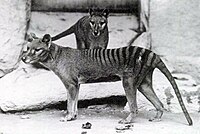
Photo from wikipedia
Milking speed (MS) and temperament (MT) are 2 workability traits of great importance in dairy cattle production and breeding. This is mainly due to an increased intensification of the worldwide… Click to show full abstract
Milking speed (MS) and temperament (MT) are 2 workability traits of great importance in dairy cattle production and breeding. This is mainly due to an increased intensification of the worldwide production systems and greater adoption of precision technologies with less human-cattle interaction. Both MS and MT are heritable traits and thus, genomic selection is a promising tool to expedite their genetic progress. However, the genetic architecture and biological mechanisms underlying the phenotypic expression of these traits remain underexplored. In this study, we investigated the association of >5.7 million imputed whole-genome sequence variants with MT and MS in 4,381 and 4,219 North American Holstein cattle, respectively. The statistical analyses were performed using a mixed linear model fitting a polygenic effect. We detected 40 and 35 significant SNPs independently associated with MT and MS, respectively, which were distributed across 26 chromosomes. Eight candidate genes (GRIN3A, KCNJ3, BOSTAUV1R417, BOSTAUV1R419, MAP2K5, KCTD3, GAP43, and LSAMP) were suggested to play an important role in MT as they are involved in biologically relevant pathways, such as glutamatergic synapse, vomeronasal receptor and oxytocin signaling. Within their coding and upstream sequences, we used an independent data set to further detect or validate significantly differentiated SNP between cattle breeds with known differences in MT. There were fewer candidate genes potentially implicated in MS, but immunity-related genes (e.g., BOLA-NC1 and LOC512672), also identified in other populations, were validated in this study. The significant SNP and novel candidate genes identified contribute to a better understanding of the biological mechanisms underlying both traits in dairy cattle. This information will also be useful for the optimization of prediction of genomic breeding values by giving greater weights to SNP located in the genomic regions identified.
Journal Title: Journal of dairy science
Year Published: 2020
Link to full text (if available)
Share on Social Media: Sign Up to like & get
recommendations!